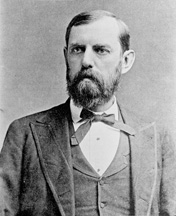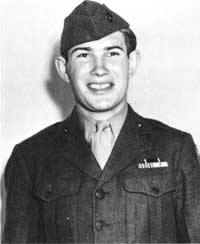Related Research Articles

Sioux Falls is the most populous city in the U.S. state of South Dakota and the 121st-most populous city in the United States. It is the county seat of Minnehaha County and also extends into northern Lincoln County to the south, which continues up to the Iowa state line. The population was 192,517 at the 2020 census, and in 2022, its estimated population was 202,078. According to city officials, the estimated population had grown to 213,891 as of early 2024. The Sioux Falls metro area accounts for more than 30% of the state's population. Chartered in 1856 on the banks of the Big Sioux River, the city is situated in the rolling hills at the junction of interstates 29 and 90.

Joseph Jacob Foss was a United States Marine Corps major and a leading Marine fighter ace in World War II. He received the Medal of Honor in recognition of his role in air combat during the Guadalcanal Campaign. In postwar years, he was an Air National Guard brigadier general, served as the 20th Governor of South Dakota (1955–1959), president of the National Rifle Association of America (NRA) and the first commissioner of the American Football League. He also was a television broadcaster.

USS South Dakota (BB-57) was the lead vessel of the four South Dakota-class fast battleships built for the United States Navy in the 1930s. The first American battleships designed after the Washington treaty system began to break down in the mid-1930s, the South Dakotas were able to take advantage of a treaty clause that allowed them to increase the main battery to 16-inch (406 mm) guns. However, congressional refusal to authorize larger battleships kept their displacement close to the Washington limit of 35,000 long tons (35,562 t). A requirement to be armored against the same caliber of guns as they carried, combined with the displacement restriction, resulted in cramped ships. Overcrowding was exacerbated by wartime modifications that considerably strengthened their anti-aircraft batteries and significantly increased their crews.

Richard Franklin Pettigrew was an American lawyer, surveyor, and land developer. He represented the Dakota Territory in the U.S. Congress and, after the Dakotas were admitted as States, he was the first U.S. Senator from South Dakota.

USS Liscome Bay (ACV/CVE-56) was the second of fifty Casablanca-class escort carriers built to serve the United States Navy during World War II. Launched in April 1943 and commissioned the following August, she was named for Liscome Bay in Dall Island in the Alexander Archipelago of Alaska. On 24 November 1943, her munitions were catastrophically detonated by a torpedo attack by the Japanese submarine I-175 while she was acting as the flagship of Carrier Division 24, which was supporting operations on Makin. She quickly sank with the loss of 644 officers and sailors. Her loss is the deadliest sinking of a carrier in the history of the United States Navy.

The Sullivan brothers were five brothers from Waterloo, Iowa who served together on the light cruiser USS Juneau. They were all killed in action during and shortly after its sinking around November 13, 1942.

James George Abourezk was an American attorney and politician. A member of the Democratic Party from South Dakota, he served as a United States senator and a United States representative for one term each; he was the first Arab to serve in the United States Senate. In 1980, Abourezk founded the American-Arab Anti-Discrimination Committee (ADC) with the goal of counteracting anti-Arab sentiment in the country. He served in the United States Navy during the Korean War, but was also a critic of United States foreign policy in the Middle East, particularly with regard to the Arab–Israeli conflict. Under his leadership, the ADC became especially active following the Iraqi invasion of Kuwait and the subsequent Gulf War, during which he became concerned about the rising rate of targeted hate crimes against Arabs and also against people misidentified as Arabs.

Charles Eugene Flandrau was an American lawyer who became influential in the Minnesota Territory, and later state, after moving there in 1853 from New York City. He served on the Minnesota Territorial Council, in the Minnesota Constitutional Convention, and on the Minnesota territorial and state supreme courts. He was also an associate justice on the Minnesota Supreme Court.

USS Stewart (DD-224) was a Clemson-class destroyer in the United States Navy during World War II. She was the second ship named for Rear Admiral Charles Stewart. Scuttled in port at Surabaya, Java, she was later raised by the Japanese and commissioned as Patrol Boat No. 102. She came back under American control in 1945 after the occupation of Japan.

Rear Admiral Charles Peshall Plunkett was an officer of the United States Navy who served in the Spanish–American War and World War I.

USS Longshaw (DD-559), a Fletcher-class destroyer, was a ship of the United States Navy named for Dr. William Longshaw, Jr. (1836–1865), who served in the Navy and was killed during the Civil War.

The Diocese of Sioux Falls is a Latin Church diocese of the Catholic Church diocese in South Dakota in the United States. It is a suffragan see of the metropolitan Archdiocese of Saint Paul and Minneapolis.

Richard Keith Sorenson was a United States Marine who, as a private, received the Medal of Honor during World War II for his heroism during the Marine landing on Kwajalein Atoll on the night of February 1–2, 1944. He threw himself on a Japanese grenade that was part of US munitions captured during the Battle of Bataan, to save the lives of five fellow Marines. Although fragments of the grenade ripped through his thighs, hips, right arm and right leg, he survived the action. Of the 27 Marines who similarly threw themselves on grenades to save the lives of their fellow Marines during World War II, Sorenson was one of only four who lived. Fellow Medal of Honor recipients Richard E. Bush, Jacklyn H. Lucas and Carlton R. Rouh were the other three survivors.

USS Hollister (DD-788) was a Gearing-class destroyer of the United States Navy, named for the three Hollister brothers, who were killed in 1943 while serving in the Navy during World War II.

USS Micka (DE-176) was a Cannon-class destroyer escort in service with the United States Navy from 1943 to 1946. She was sold for scrap in 1967.

USS Hurst (DE-250) was an Edsall-class destroyer escort in service with the United States Navy from 1943 to 1946. The ship served in both the Atlantic and the Pacific and was decommissioned in May 1946 and placed in reserve for the next 27 years.
Lambert Anthony Hoch was an American prelate of the Roman Catholic Church. He served as Bishop of Bismarck (1952–1956) and Bishop of Sioux Falls (1956–1978).

Oscar Randolph Fladmark, Jr. was an American fighter pilot who flew 164 "no-injury" combat missions in World War II and the Korean War. Fladmark received the Distinguished Flying Cross during his military career. Just a few years after the Korean War, Major Fladmark, at 33 years of age, was in an automobile accident near Yuma, Arizona, on July 27, 1955, and died while being flown to the San Diego Naval Hospital.

William Henry Leder was a fighter pilot with the United States Naval Reserve (USNR) during World War II. He is credited with scoring multiple victories during the conflict flying a Grumman F4F Wildcat. For actions during the Battle of Santa Cruz Islands he was awarded the Air Medal.

William R. Baumgartner Sr. was an American football player who played at the end position. He played college football for Minnesota from 1940 to 1942 and professional football for the Baltimore Colts during the 1947 season.
References
- This article incorporates text from the public domain Dictionary of American Naval Fighting Ships .